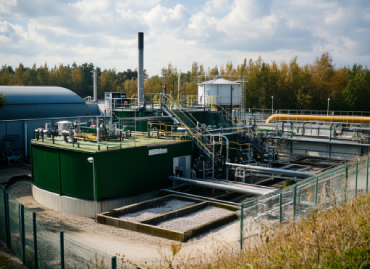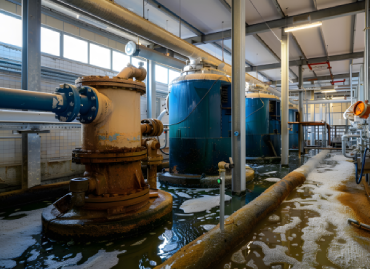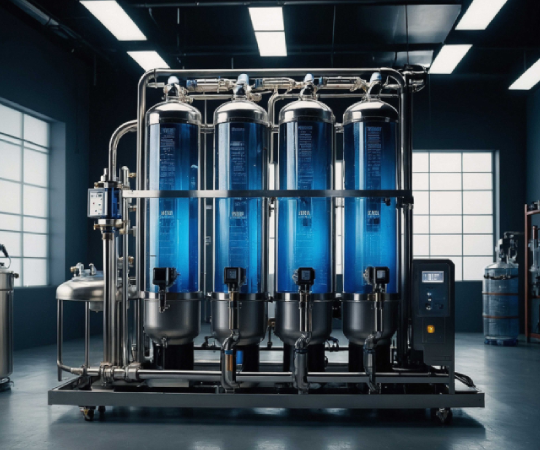- By Admin
- 16 Aug 2025
- ETP Plant
Comprehensive Water and Wastewater Treatment Solutions for Sustainable Dyeing Industry Operations and Environmental Compliance
The textile and dyeing sector in India is a vital contributor to the country's economic landscape, supporting both domestic and international markets. Maharashtra, particularly in cities like Mumbai, Bhiwandi, and Ichalkaranji, hosts numerous textile and dyeing units, benefiting from a favourable policy environment and proximity to raw materials. However, the sector faces increasing challenges related to water usage and pollution control. Water is heavily utilised throughout the dyeing process—during dye preparation, rinsing, washing, and chemical processing—making water treatment a critical aspect of sustainable operations.
In dyeing, the quality of water directly affects the final product. Soft water, in particular, is preferred, as hard water can interfere with the chemical reactions, causing inconsistent colouration or altering fabric texture. Additionally, water is required for cooling machinery, cleaning floors, and supporting boiler operations, which further adds to the water demand. Given the extensive use of water, efficient treatment and management systems are essential to minimise resource wastage and ensure regulatory compliance.
"In the dyeing industry, water is more than a utility—it's part of the product. From maintaining color consistency to removing residues, water plays a central role. Responsible sourcing and treating water not only preserve natural resources but also enhance the long-term sustainability and credibility of the business."
Wastewater Generation in Dyeing Processes
The dyeing process generates substantial amounts of wastewater from various stages, such as dye baths, rinsing tanks, de-sizing, and soaping. These wastewater streams carry a range of pollutants, including unabsorbed dyes, surfactants, salts, acids, heavy metals, and organic materials. The diversity of chemicals in the effluent makes it one of the most challenging wastewater types to treat.
Moreover, wastewater also originates from machine cleaning and floor washing, which adds detergents and other chemical waste to the discharge. The volume and variety of effluents vary depending on fabric type, dye used, and batch size. Without proper treatment, these effluents can pollute natural water bodies and violate pollution norms, thereby necessitating robust water treatment systems to safeguard both the environment and the industry's operational sustainability.


Chemical Load in Wastewater
The wastewater from dyeing industries is typically high in Chemical Oxygen Demand (COD), Biological Oxygen Demand (BOD), Total Dissolved Solids (TDS), and intense colour. These effluents often resist natural decomposition and are difficult to treat due to their chemical complexity.
Contaminants like sodium hydroxide, acetic acid, hydrogen peroxide, surfactants, and azo compounds are common in the wastewater from dyeing units. If left untreated, these pollutants can cause long-term damage to aquatic ecosystems and groundwater resources. Therefore, specialised treatment methods are necessary to address these chemical pollutants and ensure safe disposal or reuse.
Multi-Stage Treatment Technologies
Effective wastewater treatment for dyeing industries requires a multi-stage approach. Initially, neutralisation is employed to adjust the pH of the effluent. Coagulation and flocculation processes follow, where chemicals are added to help bind suspended solids and colour. Primary clarifiers and oil separators remove organic matter and sludge.
The secondary treatment typically involves biological processes such as the Activated Sludge Process (ASP) or Moving Bed Biofilm Reactor (MBBR) systems, which treat organic pollutants. In the tertiary treatment stage, filtration methods like sand and activated carbon filters, along with disinfection processes such as UV light or ozone, ensure that the treated water meets discharge standards. These treatment stages are essential in ensuring that the treated water is suitable for reuse in the plant or safe for discharge into the environment.
Advanced Recycling and Zero Liquid Discharge (ZLD)
Incorporating advanced treatment technologies like Membrane Bioreactors (MBR), Ultrafiltration (UF), and Reverse Osmosis (RO) has revolutionised wastewater treatment in dyeing plants. These systems are highly efficient in removing micro-pollutants, salts, and dyes, enabling water recycling and reuse. RO, in particular, plays a crucial role in purifying water to a level where it can be reused for various processes within the plant.
Automation and SCADA-based monitoring systems are increasingly integrated into treatment plants to ensure operational efficiency and real-time tracking of system performance. Many dyeing units are moving toward Zero Liquid Discharge (ZLD) practices, where all wastewater is treated, recycled, and reused within the plant, drastically reducing freshwater dependence and adhering to stringent environmental mandates.
Customised Water Treatment Solutions for Dyeing
We offer tailor-made water and wastewater treatment solutions specifically designed for the dyeing and textile sector. Our services cover everything from effluent treatment plants (ETPs), Sewage Treatment Plants (STPs), and Water Treatment Plants (WTPs) to Reverse Osmosis (RO) systems and Zero Liquid Discharge (ZLD) setups. Each solution is customised based on the type of fabric, dyeing process, and specific discharge requirements of the plant.
We specialise in design, supply, installation, automation, and post-commissioning support. Additionally, we offer upgrades for older systems to meet the latest pollution control norms and regulations. We aim to provide efficient and sustainable treatment systems that not only help industries stay compliant but also optimise operational costs and resource utilisation.
Summary And Conclusion
Sustainable water and wastewater management in the dyeing industry is crucial for both environmental protection and operational efficiency. Advanced technologies like Membrane Bioreactors (MBR), Reverse Osmosis (RO), and Zero Liquid Discharge (ZLD) are transforming the industry by enabling water recycling and reducing freshwater dependence. Multi-stage treatment processes, including neutralisation, biological treatment, and filtration, ensure that wastewater is treated effectively for reuse or safe discharge. Customised water treatment solutions help dyeing industries comply with regulations, reduce costs, and enhance sustainability. As the sector continues to grow, these solutions will be vital in addressing water and environmental challenges.































































